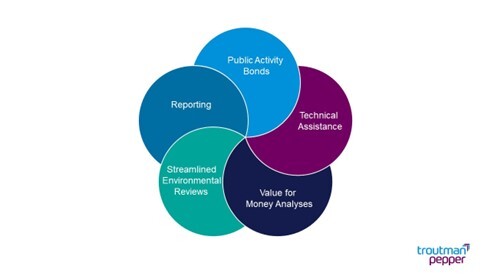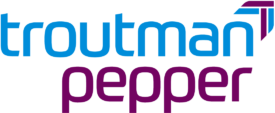The $1.2 trillion Infrastructure Investment and Jobs Act (IIJA) is poised to change how the United States views and implements public-private partnerships (P3s). At a high level, the IIJA encourages public entities to consider P3s and incentivizes private entities to engage in the P3 market by dismantling roadblocks that have prevented the widespread adoption of P3s in the U.S. — including by removing government red-tape, increasing the availability of federal funding, and delivering much needed technical expertise and guidance to successfully execute P3s. In this article, the first in a series, we explore (1) the doubling of private activity bonds, (2) a P3 technical assistance program for government agencies, (3) TIFIA driven value-for-money analyses, (4) the streamlining of important environmental reviews, and (5) the creation of a government reporting feedback loop on P3 projects.

The IIJA doubles the amount of available private activity bonds, creating an increase in P3 funding.
The IIJA doubles the cap on private activity bonds (PABs) for qualified highway and rail freight transfer facility projects — doubling the existing $15 billion to $30 billion.[1] This is important for parties financing P3s. PABs allow the issuance of tax-free municipal bonds to private entities financing qualified projects. PABs are often a critical component in achieving P3 project feasibility, especially for large projects where PABs are paid back with revenue from project user fees or availability payments during the operation of the project. To date, the U.S. DOT has allocated approximately $16.9 billion to support projects across the country. Some of the most recent projects supported by PABs include:
- Pennsylvania Bridge P3 Initiative – Package 1: $1,759,135,000
- Indiana East End Crossing Ohio River Bridges: $676,805,000
- Texas North Tarrant Expressway 3C: $653,865,000
- Virginia Capital Beltway HOT Lanes: $589,000,000
The IIJA allocates money for P3 technical assistance programs to increase confidence in P3 execution.
To address an overall deficiency in P3 market expertise, the IIJA establishes a grant program, which provides funding for state and local governments to obtain P3 technical assistance and expert consulting services.[2] The program is funded with $20 million each year, running through 2025. Grants may be awarded in amounts up to $2 million per project. Government recipients may use such funds to retain the services of P3 consultants, identify appropriate P3 projects, solicit projects, and negotiate projects, among other things. These expert services will enhance public entities’ technical capacity to see P3 projects through from start to end and will help mature the U.S. P3 market.
New TIFIA loan requirements will help drive thoughtful analysis and appropriate investment in the U.S. P3 market.
Transportation Infrastructure Finance and Innovation (TIFIA) loans are a crucial source of financing for certain surface transportation projects, such as highways and bridges, because they offer low interest, long-term financing. To date, TIFIA loans have supported a substantial portion of U.S. surface transportation P3s that have reached financial close. The IIJA both renews TIFIA funds and requires applicants to undertake critical analyses during the application process.
Under the new TIFIA loan requirements, public or private entities applying for a loan for certain projects over $750 million must perform a value-for-money (VFM) analysis during the planning and project development phases. [3] VFM analyses require applicants to consider the following:
- The lifecycle cost and project delivery schedule;
- The costs of using public funding versus private financing for the project;
- A description of the key assumptions made in developing the analysis, including any grants, loans, or subsidies received for the project; a discussion of the benefits and costs associated with the allocation of risks; and any externality benefits for the public generated by the project; and
- A forecast of user fees and other revenues the project expects to generate (if applicable).
The P3 model is not the best model for every project. Requiring VFM analyses to be undertaken by all TIFIA applicants may help to standardize the use of this important gate keeper and ultimately lead to a more robust market over time, with resources appropriately allocated to projects best completed through a P3 structure.
The codification of the One Federal Decision process will streamline environmental reviews.
A key provision of the IIJA codifies the One Federal Decision process, establishing a two-year time limit for completing the National Environmental Policy Act (NEPA) review and permitting processes for major infrastructure projects.[4] Certain federal actions trigger NEPA reviews, including federal funding, granting federal permits or approvals, and allowing projects to take place on federal property. Streamlining these reviews are critical for P3 projects. A recent Government Accountability Office study found that the average time to complete a NEPA review is 4.5 years, with some reviews taking more than a decade to complete.[5] The study also found that delays in the review and permitting process can add significant costs to infrastructure projects: estimates ranging from $3 million to $25 million per month of delay. Consequently, prolonged NEPA reviews have thwarted several potential P3 projects.
The codification of the One Federal Decision process establishes clear timelines for completing NEPA processes, which should help reduce uncertainty in the procurement process, deflate overall project costs due to fewer built-in contingencies, and ultimately, improve project outcomes.
Congressional reporting requirements intend to help Congress remove P3 roadblocks.
Congress has a strong interest in increasing P3s in the transportation infrastructure sector long after the IIJA phases out. This is because P3s match the growing needs of the public sector with the expertise and available capital of the private sector. And because Congress does not want U.S. infrastructure to crumble again due to the lack of insufficient funding. To that end, Congress has developed different reporting requirements to obtain information about P3s that will likely inform additional legislation down the road.
There are two main reporting requirements in the IIJA that specifically relate to transportation infrastructure P3s. First, the secretary of transportation must provide Congress with a report by 2024 that discusses any impediments in applicable laws, regulations, and practices hindering the development of P3s. This report also will set out proposals to address any identified impediments, helping to reduce issues perceived to hamper private investment in transportation projects.[6] Second, the secretary of transportation also must report on the VFM analyses submitted with TIFIA applications. This report must be submitted to Congress by the end of 2023.[7] The report will analyze the use of private financing for projects and identify best practices for carrying out P3s based on the data.
Key Takeaways
These five provisions of the IIJA help set the stage for increased investment in the U.S. P3 market, particularly in the transportation infrastructure sector. And as P3 popularity grows — as the U.S. is seeing now — it is likely that the use of the P3 model will continue to expand. Governments and private companies that frequently use P3s or are interested in using them in the future should take heed of the benefits of the provisions: (1) increasing the caps on PABs, (2) providing resources for government agencies, (3) requiring VFM analyses for TIFIA funds, and (4) providing a two-year maximum period for NEPA reviews.
The IIJA is a significant piece of legislation that addresses some of the most pressing issues facing U.S. transportation infrastructure. By doubling the cap on PABs, allocating funds for P3 technical assistance programs, and adding a new value-for-money analysis requirement for TIFIA loans, the IIJA will likely drive interest in P3s in the U.S. Additionally, the codification of the One Federal Decision process is expected to streamline environmental reviews and reduce uncertainty, making it easier for private entities to invest in both the planning and the execution of transportation P3 projects. The IIJA represents a substantial step forward in the effort to modernize and improve U.S. transportation infrastructure, and its impact will likely be felt for years to come. As the government continues to prioritize P3 projects and provide support for their development, private entities will have more opportunities to collaborate with public entities and drive innovation in transportation infrastructure.
Troutman Pepper’s interdisciplinary team of attorneys help companies and public entities at every step of the P3 process. Please contact us if you have any questions.
[1] Infrastructure Investment and Jobs Act, Pub. L. No. 117-58, § 80403, 135 Stat. 429, 1335 (2021).
[2] Infrastructure Investment and Jobs Act, Pub. L. No. 117-58, § 71001, 135 Stat. 429, 1318 (2021).
[3] Infrastructure Investment and Jobs Act, Pub. L. No. 117-58, § 70701, 135 Stat. 429, 1286 (2021).
[4] Infrastructure Investment and Jobs Act, Pub. L. No. 117-58, § 11301, 135 Stat. 429, 525 (2021).
[5] Exec. Off. Of the President, Counsel on Env’t Quality, Environmental Impact Statement Timelines (2010-2018) (June 12, 2020).
[6] Infrastructure Investment and Jobs Act, Pub. L. No. 117-58, § 71001, 135 Stat. 429, 1320 (2021).
[7] Infrastructure Investment and Jobs Act, Pub. L. No. 117-58, § 70701, 135 Stat. 429, 1287 (2021).

